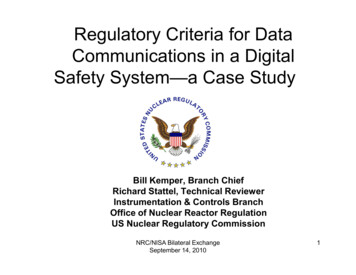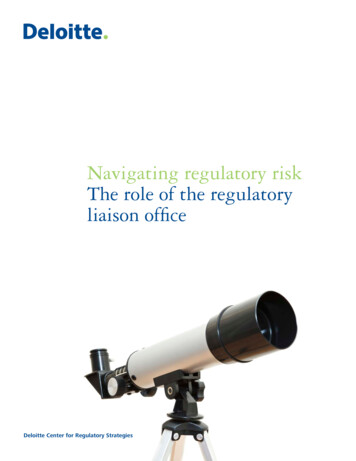
Transcription
Regulatory Criteria for DataCommunications in a DigitalSafety System—a Case StudyBill Kemper, Branch ChiefRichard Stattel, Technical ReviewerInstrumentation & Controls BranchOffice of Nuclear Reactor RegulationUS Nuclear Regulatory CommissionNRC/NISA Bilateral ExchangeSeptember 14, 20101
Presentation Outline Background Introduction Communication– Architecture– Regulatory Guidance– Detailed Communication Design CCF & Diversity and Defense in Depth– Common Cause Failure– Connections with Backup Actuation Systems Digital RPS/ESPS Diverse Actuation SystemsNRC/NISA Bilateral ExchangeSeptember 14, 20102
BackgroundTXS Platform & Oconee LAR The Safety Evaluation Report for the Teleperm XS (TXS) Topical Report wasIssued in May 2000.On January 31, 2008, Oconee submitted a LAR to replace the existing analogRPS and ESPS systems with a Digital RPS/ESPS system.The Oconee Digital Reactor Protective System / Engineered SafeguardProtective System (RPS/ESPS) is Based on the TXS Platform.As part of the NRR acceptance review process the NRC accepted the LAR(April 2424, 2008) for review and documented six issues that could present achallenge to approving the LAR:– (1) Diversity and Defense-in-Depth (D3)– (2) Bi-Directional Communications– (3) AREVA Software Program Manual (SPM)– (4) TXS Platform Changes since the approval of the TXS topical Report– (5) Verification and Validation (V&V) program / process– (6) Software Tools used for V&VNRC/NISA Bilateral ExchangeSeptember 14, 20103
BackgroundScope of LAR Replaced Analog RPS and ESPS logic with TXS based digitallogic Added Two Diverse Actuation Systems– Diverse Low Pressure Injection Actuation System– Diverse High Pressure Injection Actuation System Changedg technical specificationsp– To account for system changes– To change surveillance requirements Minor Operator Control and Indication Changes– All are conventional analog vs. digital displaysNRC/NISA Bilateral ExchangeSeptember 14, 20104
BackgroundOconee Controls and Displays Service Unit is used for maintenance functions only– Does not display information that the operators will use whilemanipulating the safety controls– Does not control any safety function actuation Some conventional indications and controls were changedg– ESPS Auto/Manual pushbuttons Were component based Will be logic channel basedNRC/NISA Bilateral ExchangeSeptember 14, 20105
IntroductionReview Process EICB has conducted the review in accordance with Standard ReviewPlan (SRP) Chapter 7 (NUREG-0800, Chapter 7) and LIC -101. Interim Staff Guidance (ISG) was developed by the Task WorkingGroups (TWGs) of the Digital I&C Steering Committee. Specifically:– ISG#2 was used to guide the review of Diversity and Defense-in-Depth aspects.–ISG#4 was used to guide the review of Communications aspects Regulatory Guide 1.152 Rev. 2, “Criteria for use of Computers in SafetySystems of Nuclear Power Plants,” Regulatory Position C.2, “Security”– TXS Platform– Oconee ApplicationNRC/NISA Bilateral ExchangeSeptember 14, 20106
CommunicationRegulatory Guidance Regulatory Guidance for Communication– IEEE 603, “IEEE Standard Criteria for Safety Systems forNuclear Power Generating Stations”– IEEE 7-4.3.2, “Standard Criteria for Digital Computer inSafetyy Systemsyof Nuclear Power Generatingg Station”– ISG#4, “Highly Integrated Control RoomsCommunication Issues” Available at igital/regsguidance.htmlNRC/NISA Bilateral ExchangeSeptember 14, 20107
Overview of Oconee ApplicationRPS/ESPS System ArchitectureESFESFNRC/NISA Bilateral ExchangeSeptember 14, 20108
Overview of Oconee ApplicationReactor Trip BreakersNRC/NISA Bilateral ExchangeSeptember 14, 20109
Overview of Oconee ApplicationSafety to Safety Communication ArchitectureData Communications Between Safety DivisionsNRC/NISA Bilateral10ExchangeSeptember 14, 2010
Overview of Oconee ApplicationSafety to Non-Safety Communication ArchitectureNRC/NISA Bilateral ExchangeSeptember 14, 201011
CommunicationBetween Safety and Non-safety SystemsProfibus- Bi-directional communication between safety system and Service Unit- One way communication between safety system and gateway to OACNRC/NISA Bilateral ExchangeSeptember 14, 201012
Diversity and Defense in DepthOconee Diversity Solution Both RPS and ESPS are postulated to fail due to SoftwareCommon Cause Failure (CCF). ESPS - Design Basis Safety System Actuations Reactor Building Spray (manual backup) Reactor Building Cooling and Isolation (manual backup)– New Automatic Diverse Actuation Systems High Pressure Safety Injection Actuation System Low Pressure Safety Injection Actuation System RPS - Design Basis Safety System Actuation– Existing Automatic Diverse Reactor Trip System isCredited for DiversityNRC/NISA Bilateral ExchangeSeptember 14, 201013
Diversity and Defense in DepthDiverse LPI Actuation System (DAS)NRC/NISA Bilateral ExchangeSeptember 14, 201014
Regulatory Criteria for Data Communications in aDigital Safety System—a Case StudyQuestions?NRC/NISA Bilateral ExchangeSeptember 14, 201015
Background TXS Platform & Oconee LAR The Safety Evaluation Report for the Teleperm XS (TXS) Topical Report was Issued in May 2000. On January 31, 2008, Oconee submitted a LAR to replace the existing analog RPS and ESPS systems with a Digital RPS/ESPS system. The Oconee Digital Reactor Protective System / Engineered Safeguard Protective System (RPS/ESPS) is Based on the TXS Platform.











